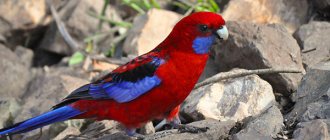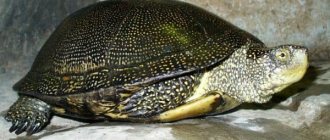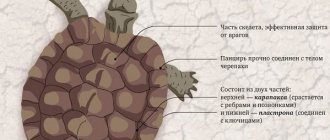The Amazon parrot is a pet that is often purchased by lovers of exotic birds. It is distinguished from other birds by its extraordinary intelligence, peculiar behavior, and long life expectancy. Amazons quickly get used to humans and can learn to speak. They are unpretentious, but in order for your pet to feel comfortable, you need to know the peculiarities of keeping representatives of this genus at home.
Description
Amazon parrots are large birds. The size of the body is 25 - 45 cm, while the weight of the pet can reach 500 g. The bird has bright, dense green plumage, which may have red, yellow or blue spots on the forehead, back of the head, wings, cheeks, tail or chest. They are used to determine whether a parrot belongs to one species or another. The beak of the Amazon parrot is strong, smooth, shiny, short, has a sharp-edged base and a curved end. It is capable of crushing large nuts.
The age of a bird is determined by the iris of the eye. In young individuals it has a grayish tint. In birds that have reached the age of three, the iris becomes chestnut in color. After this, determining the age of the parrot becomes very difficult. You can find out the sex of a bird by its behavior during the mating season. If there is only one individual, then only a veterinarian can determine it.
Appearance
Basically, the difference between a male and a female in size is very insignificant, and in onomatopoeic abilities too, but the appearance, as they say, is variable. Nature did not spare bright colors for the plumage of this bird.
A feature of Amazons is sexual dimorphism: in rare species, females can be distinguished from males by their appearance. Basically, in order to figure it out, parrots are gathered into a heap: parrots of the same sex will behave indifferently, and in a male-female pair, the men immediately begin to court the ladies.
But this is if they have already matured to the desire to reproduce. You can distinguish a mature parrot from a chick and a teenager by the color of the iris: in adults it is bright orange, reddish-brownish, and in young animals it is bluish-brown.
Appearance of an Amazon parrot
Amazons in the wild
Amazon birds prefer to inhabit the warm and humid tropical forests and savannas of Central and South America, as well as the Caribbean islands. They spend most of their time in the branches of tall trees. They gather in small flocks. When the nesting period begins, they form pairs. These are very noisy birds, they constantly scream, no matter what they do: waking up early in the morning with the first rays of the sun, they begin roll call and tell each other the news, in the evening before going to bed they sort things out among themselves for a place on a branch , and they also scream when they are looking for food and even when they are just resting.
Their diet consists of:
- fruits,
- seeds,
- nuts,
- mango and coffee fruits,
- young shoots,
- flowers and leaves.
Parrot intelligence
It is believed that the thinking abilities of the Amazon are slightly more modest than those of its African fellow African Gray, but Amazons are recognized as the best onomatopoeists among American parrots. They brilliantly reproduce natural sounds (including animal cries), imitate human speech and the sound of musical instruments, and also whistle their favorite melodies.
Amazon parrots are quite good at taming, and once they get used to their owner, they can be trained, memorizing simple circus tricks. These birds love to be the center of everyone's attention, and therefore do not hesitate to talk in front of a large crowd of people. They become attached to their owner and are well adapted to life in captivity . The calmest domestic recluses include the white-fronted, Brazilian, yellow-fronted, red-fronted, Surinamese, blue-fronted and Venezuelan Amazons.
Appearance, colors
Amazons are not particularly impressive, but they amaze with their variety of colors while maintaining the consistent green background of their plumage, which is characteristic of almost all species.
The distinctive mark of each species is the noticeable colored spots decorating the neck, head (including the back of the head), wings and tail. These marks scattered throughout the body can be bright red, yellow, lilac, blue, blue and more.
This is interesting! The iris of the eye in young parrots is gray-brown, which changes to chestnut-brown, red-orange or red by the age of 2-3 years. During this period, it is especially difficult to determine the age of a parrot based on the iris.
It is also difficult to determine the sex of an adult bird based only on its exterior. It is much easier to do this when the parrots are in a group, demonstrating mating behavior.
Types of Amazons
According to different classifications, the genus of Amazonian parrots includes from 26 to 32 species, and two of them have already disappeared from the face of the earth.
Here is just part of the species diversity of Amazon parrots:
- white-fronted and blue-fronted Amazons;
- yellow-shouldered and yellow-necked Amazons;
- Venezuelan and red-tailed Amazons;
- red-breasted and red-fronted Amazons;
- Jamaican Black-billed and Yellow-billed Amazons;
- blue-cheeked and blue-capped Amazons;
- festive and luxury Amazons;
- Cuban and Soldier Amazons;
- royal and imperial Amazons;
- Suriname and yellow-headed Amazons;
- Muller's Amazon.
Nowadays, several species of Amazonian parrots (due to the threat of extinction) are included in the International Red Book.
Varieties
The most famous varieties of Amazon parrots that are suitable for keeping at home:
- The Surinamese, also called the yellow-fronted Amazon, is a medium-sized parrot. The length of its body is less than 40 cm. It has green feathers all over its body, and there is a yellow spot on the frontal part of its head.
- Amazon yellow-headed is a parrot with a body length of 40-41 cm. The head and front of the neck are painted bright yellow. A dark green edging runs along the back, chest and neck. There are red blotches on the upper part of the wings. Some representatives of this species may have lemon spots on other parts of the body.
- Red-fronted Amazon. This parrot is also called the yellow-cheeked parrot. He has a bright, memorable appearance. The body is medium-sized - 34-36 cm in length, weight - 350-480 g. Males are larger than females. The red-fronted Amazon is green, there is a black edging on the back of the head, a bright red spot on the forehead, and yellow cheeks. Powerful paws are painted gray, the color of the iris is orange.
- Muller's Amazon is a large bird from the parrot family. Its body length reaches 43-45 cm, and its weight is 500-700 g. The color of the feathers is green with a light gray tint. When you look at the parrot, you get the impression that it has been sprinkled with flour. A distinctive feature of Muller's Amazon is a purple-gray edging on the back of the head. There is a lemon stain on the forehead. The iris of a parrot's eyes is chestnut-brown or red, and its paws are gray.
- The white-headed Cuban Amazon is a very beautiful medium-sized parrot: body length - 30-35 cm, weight - 350-450 g. Its peculiarity is a large white spot on the head, which extends to the frontal part, covers the eyes and reaches the top of the head. The neck, cheek area and part of the chest are colored pink-red. There is a purple spot on the parrot's belly, and the flight coverts are colored blue. The paws are brown, the iris of the eyes is brown. The tail plumage is emerald green with a bright yellow frame. It contains single red feathers.
- Blue-fronted Amazon. This is a medium sized parrot. The length of its body ranges from 35-40 cm. Weight is 400-500 g. On the upper part of the body the plumage is decorated with malachite edging. There is a blue spot on the forehead. The parietal area of the head, neck and cheeks are yellow. The parrot's beak is coal-black, its paws are gray. The feathers on the wing fold are bright red. The eye color of mature individuals is brown or reddish.
- Venezuelan Amazon. This parrot looks almost like a blue-fronted parrot, but it is a little smaller - 30-31 cm in length, its weight rarely exceeds 350 g. There are blue specks on the forehead, and there is a red stripe on the flight feathers. The beak is brownish-yellow, the tip is dark. The eyes are orange.
There are about 30 species of Amazon parrots. Of these, 18 are recorded in the Red Book. Birds of the same species from different geographical areas may differ from each other in body size and color.
Parrot Amazon: keeping at home
A parrot needs a spacious cage, a balanced diet and active leisure. Temperature and insolation play an important role in Amazon health. The owner is obliged to provide his pet with comfortable conditions and exercise with him.
Conditions of detention and care:
- Wet air. The inhabitants of tropical forests react poorly to dry air in the apartment; their feathers dry out and break. Keep an aquarium or use humidifiers.
- Bathing. You can bathe your parrot using a spray bottle, spraying it once a week. After spraying, be sure to dry the plumage with a hairdryer, expose the bird to the sun, or simply leave it alone for 2 hours so that it can spread its wings and dry the inner feathers. Features of the Amazon plumage are the absence of protective “powder” on the feathers. When bathing, the feathers become very wet and if they are not dried completely, they will begin to rot and smell bad. The parrot will become nervous and lose feathers.
- Air temperature. Constantly maintain the air temperature in the room at 22 - 25 ° C. Do not place the cage in a draft so as not to catch your pet's cold.
- Nutrition. Include fruit in your parrot's diet every day. Under natural conditions in its habitat, fruits are available all year round. Wood branches placed within the parrot's reach will help him maintain his beak in the desired shape.
- First appearance in the house. You can start housetraining your parrot 2 weeks after purchasing it. In the room, close all doors and windows, remove all pets and release the chick from the cage. Let him walk around the floor and get acquainted with the situation. If the bird does not want to go back into the cage, use a net. Proceed carefully so as not to scare the parrot.
- Taming an Amazon chick. The bird makes contact easily. It is enough not to frighten her or offend her. First, we accustom the chick to the hand, then it will begin to take food from the palms, and then it will fearlessly sit on the hand. It is convenient to use special sticks with a sharp tip. A piece of food is placed on the end of a stick and presented to the bird. Gradually the stick is shortened, and the chick moves closer to the hands.
- Leisure. You need to place a lot of toys in the cage. The active birds will entertain themselves all day long. The parrot will be happy to hang upside down on a perch, look at itself in the mirror, and rub the wheel with its beak.
- Education. Amazons are able to remember up to 100 words and are interesting to communicate with; the parrot is capable of expressing emotions, the intelligence of some species corresponds to the development level of a 3-year-old child. You need to practice for 15 minutes twice a day, protecting the bird from extraneous sounds. First, master sounds with your pet, then simple monosyllabic words. Young birds learn faster. Birds perceive female high-pitched voices better.
Amazons can live alone. If raised correctly, they will not show aggression. If you have no experience with parrots before, you should pay attention to the Venezuelan Amazon. It is relatively inexpensive and unpretentious, easily tamed, and gets along well with small children.
Some tips on how to choose a Venezuelan Amazon parrot
- When purchasing a parrot, give preference to a young individual (5 months); It will be easier to establish contact with him.
- A young parrot has brown irises and faded plumage.
- The beak of a parrot of this breed should be dark in color, brown or black.
- There should be yellow spots on the forehead and cheeks.
- The skin around the eyes is blue-violet.
- The undertail is red.
- There are yellow and red feathers on the wings.
- It is impossible to distinguish a female from a male, but the ability of parrots to learn does not depend on the sex of the bird.
Aviary or cage
The cage for keeping an Amazon must be spacious. A dome-shaped option with unpainted stainless steel rods is suitable. The height, length and width of the cage must be at least one meter. It is better to place feeders and perches at the top. It is important to create conditions for your pet so that it can fly without touching other objects.
If it is not possible to install a spacious aviary, you should arrange a room in which the bird could walk for a long time. The room should be equipped with a play area for the pet, the window should be closed and small items should be removed. Curved branches, ladders, ropes, and bright rattling toys are placed in a designated area for the parrot.
We recommend reading: Kea parrot - sheep hunter
The cage must be cleaned every day. Sawdust placed at the bottom will simplify the task. Plant food should not be in the feeder for more than 8 hours, as it attracts insects, which are a source of pathogenic bacteria.
Diet
When purchasing an Amazon, owners usually make grain mixtures the basis of its diet. However, in the natural environment this type of food makes up only a small part. Parrots feed mainly on fruits, plant buds and flowers. Birds enjoy eating:
- carrots and pumpkin;
- apples, pears;
- peeled citrus fruits (oranges, lemons, grapefruits);
- berries (sea buckthorn, blueberries, rowan, cherry, rose hips, cranberries, viburnum and lingonberries);
- plums, peaches, apricots;
- bananas, melons, watermelons;
- chamomile, pear, apple, lilac, cherry, rose hip, dandelion flowers.
Both fresh and frozen berries are suitable. But in the second case, they can be given to the pet after they reach room temperature. It is recommended to include in the diet purees and juices intended for baby food, porridge cooked in water, sprouted grains, and soaked dried fruits.
May harm your pet's health:
- mango;
- papaya;
- persimmon;
- avocado;
- potato;
- dairy products;
- meat;
- sugar, chocolate and other sweets;
- mushrooms;
- seafood and fish;
- flour products;
- cabbage, onions, tomatoes, eggplants;
- coffee and alcoholic drinks;
- parsley and other greens with a significant content of essential oils.
Grain feed should not exceed 40% of the total diet. For feeding birds, mixtures intended for medium-sized parrots are suitable. Some pets do not eat millet and canary grass, preferring whole spikelets, which can be purchased at a pet store.
Protein foods should be present in the diet in moderation. Birds that do not reproduce are given a small portion of low-fat cottage cheese and a little boiled quail egg no more than once a month.
The daily amount of food should not exceed 50 grams for one individual. Mineral supplements must be present in the diet. It is also necessary to ensure that the water in the drinking bowl is always fresh.
Care and hygiene
Feathered pets live at home for up to 50 years, but there are cases when an individual reached the age of 70 years. The life expectancy of a pet is influenced by the conditions of its detention.
In their natural environment, representatives of this genus of birds prefer a tropical climate, so it is important that the temperature in the room in which the bird is located does not fall below 18 degrees. In addition, dry air is contraindicated for a parrot. Favorable living conditions for a pet are temperatures from 24 to 27 degrees and humidity over 60%. During the heating season, a humidifier will help create a comfortable environment. If it is not there, hang a wet cloth on the battery and spray the bird with water several times a day.
Birds like water treatments, so a container is placed in the enclosure where the pet can swim. It is recommended for the parrot to take a warm shower twice a month. Inadequate living conditions can lead to itching, dandruff and feather loss.
Wing clipping
If you are worried that your pet will fly away while outside the cage or enclosure, you can trim its wings a little. You will need an assistant:
- prepare hydrogen peroxide or any blood-stopping agent in advance; you will use it if you accidentally trim young, just developing feathers;
- wrap the Amazon in a towel, hiding its beak and claws so that it does not scratch you;
- take out the wing and feel for the largest feathers in the first row. Trim the 7 outer feathers with scissors.
Training, is it possible to teach to speak?
Amazon parrots are fearless, confident birds, active and can be impudent and start to misbehave. Therefore, it is important to stop this behavior immediately and start raising your pet as soon as you have one in your home.
Amazons constantly demand attention; if they get bored without you, they will start screaming loudly. To prevent this cry from becoming permanent, teach him the rules of behavior.
If you are a lover of silence, consider choosing a different parrot. With the advent of Amazon in your home, you will not see silence.
The loudness of these birds is innate, especially in the mornings and evenings. To shorten the duration of the calls, cover the bird with a dark cloth - this will teach it the signal that it is time to sleep.
This is how they will wake you up in the morning:
Parrots are in a changeable mood: a minute ago he was whistling merrily and jumping around the cage, and now he is sitting, turned away and buried in a toy. This is normal behavior for Amazon.
Amazonian birds are excellent talkers; they quickly and easily remember words and phrases, cheerfully sing the songs they have been taught, and also recite poetry. Don't forget to reward your pet with a treat for every successful attempt. They can meow, imitate the sound of human laughter, telephone ringing, and doorbell ringing. Their vocabulary can be up to 100 words. The blue-fronted and yellow-headed Amazons are especially talkative.
How to distinguish between a female and a male
For many parrots, determining their gender is quite difficult, and sometimes even experienced ornithologists cannot cope with this task. This also applies to Amazons, so to get accurate information, many owners resort to DNA analysis (with double analysis, the accuracy of the results increases to 100%) or endoscopy. In the first case, a fallen feather from a bird is perfect as a sample for research, but in the second, it will have to be put to sleep for a while and an incision made on its belly.
Of course, it is extremely unwise to torture your pet just to find out whether it is a boy or a girl, but when breeding parrots, many owners do this. In addition, you can obtain the necessary material for DNA testing by taking blood from a vein on the wing. If you have several Amazons at home, then you can find out which of them is which by their behavior during puberty.
Typically, parrots that have reached the age of four are considered sexually mature, which means from this moment (if you keep several birds together) you can easily wait for a new addition to the bird family. Usually there are two eggs in the nest at the same time, and the offspring are born after a month of incubation. Mature Amazons fly out of the “home” approximately two months after hatching, and they become completely independent after another month. When breeding in an aviary, there must be a nesting box, the normal dimensions of which are 35x35x80 cm.
Owner reviews
People who live near Amazon parrots warn that their pets are very vocal, especially in the morning. When they wake up, they like to chat and sing songs. To avoid early morning wake-ups, cover the cage with a cloth at night.
Amazons are independent to the point of rudeness and often “resist” no worse than donkeys until they get what they want. The character is more reminiscent of a woman’s: the parrot’s mood changes every minute. Amazon can switch from enthusiastic joy to severe melancholy in one second, showing with all his appearance the dissatisfaction that has gripped him.
Important! By biting, an Amazon can injure its owner. Bites are guaranteed for those household members who the bird does not like. In the heat of jealousy, the Amazon injures other pets and does not spare children.
The main thing to remember when getting a bird is that once it reaches maturity, it will become extremely aggressive.
Breeding Amazons at home
These parrots become sexually mature at approximately four years of age.
Breeders do not experience any particular problems in their reproduction. Individuals that like each other will fluff out their cheeks and tail in front of each other, open their wings slightly, and also raise the feathers on the nape. The female lays a clutch of two or three eggs, incubation lasts 26-29 days. During this period, the male feeds the expectant mother. Grown chicks leave the nest at the age of seven to nine weeks. But they are under the care of their parents for another month.
There is only one big problem that breeders may encounter during the breeding process - the aggressiveness and destructiveness of Amazons during the mating season. Anyone approaching the cage can be attacked. Be careful and make sure that during this period the bird moves less in the wild.
Attention! Amazons who have lived alone for a long time, not in a pack, are not suitable for the role of parents. They are capable of destroying eggs and offspring.
How to choose the right one and how much it costs
People who want to have a pet sometimes find it difficult to choose the right puppy or kitten for them, let alone parrots. Amazons are difficult to distinguish by gender, but this is not the most important thing when purchasing. If a person does not understand such birds at all, then they may well be sold an old individual or a sick representative of the species, so ideally it is worth looking for parrots with a non-removable ring. It is on this additional detail that information about the Amazon’s previous place of residence is usually stamped, down to the address of the nursery and the date of birth of the chick.
Birds raised in good conditions are always completely tame and do not appear afraid. There are several important points that you must pay attention to when choosing amazons: normally, the feathers should be clean and fit snugly to the body; if the eyes are shiny, the bird is healthy; the beak must be of the correct shape; the breast bone should not protrude (if this is not the case, then the bird is either sick or emaciated); breathing is even and measured.
By buying a bird from a nursery, you will have a much better chance of getting true information about its real age and gender, which is important if you want to teach your new pet human speech or simply start breeding Amazons at home.
Important! When choosing, be sure to pay attention to the parrot's eyes. In young Amazons (up to about two years of age), the iris is gray-brown and may even appear dirty. The older the parrot, the more its eyes become red-orange, and now it is almost impossible to determine the true age of the birds. As for the price, it all depends on where the parrot was purchased: poachers sell them on the black market for $200-300, while in nurseries you can get $1,000 per bird.
What diseases can this breed have?
Like all living things, the chic Amazon is not immune to various diseases. You can determine that a bird is not healthy by its behavior: the parrot becomes less active, sits ruffled for a long time, nervously pulls out feathers, or begins to limp on one of its legs. What can this tell the owner?
A number of specific diseases are common among large parrots - these can be as simple as banal inconveniences:
- Beak and claws too long;
- Vitamin deficiency - in this case, most birds begin to pluck feathers;
- Stress - a bird can either hide and calm down or scream in alarm;
- Aggression before mating season.
So are signs of developing diseases, such as:
- Dandruff, feather mites - in this case, feathers become brittle and the beak can flake;
- Psittacosis is an infectious disease that is dangerous for both the parrot and the bird owner. The first manifestations are characterized by fever, drowsiness, loose stools, watery eyes and flow from the beak. Caused by an intracellular parasite.
- Fracture of a wing or one of the legs - when moving, the parrot makes a characteristic bevel towards the affected limb;
- Scratches - the bird is trying to reach the affected area and peck out the obstacle from there;
- A cold is identified by difficulty breathing and coughing sounds.
If the owner notices one or a set of symptoms in the pet, the bird should be immediately taken to the veterinarian. Due to the constant vertical position of the bird, a common cold can easily turn into pneumonia and can only be helped by a course of antibiotics, after which there will be an equally difficult recovery period.
Parrot diseases, prevention
Not everyone knows what a healthy Amazon should look like, but there are several defining signs:
- beak – shiny and smooth, without peeling/layering;
- the plumage is dense and bright, without blackened feathers;
- eyes are clear, not squinted;
- paws – full and powerful, with evenly thickened toes;
- the skin on the paws is shiny and smooth, with no folds or peeling.
- behavior is calm, without apathy and nervous breakdowns.
Amazons are susceptible to ailments common to many parrots.
These diseases are bacterial, viral or fungal in nature:
- glandular stomach dilatation syndrome;
- salmonellosis and chlamydia;
- pseudotuberculosis and tuberculosis;
- papillomatosis and polyomavirus;
- paramyxovirus and circovirus;
- herpesvirus infection of parrots;
- candidiasis and cryptococcosis;
- aspergillosis and malassezia;
- megabacteriosis of parrots.
Be wary if your bird has become lethargic, has become ruffled and disheveled, is not eating well, has lost weight, is wheezing or sneezing, has fallen from its perch, is limping, trembling and is drowsy.
Important! Any of these symptoms will be a signal for an urgent visit to the clinic.
Alarming symptoms include self-plucking, beak overgrowth, redness of the nose/cloaca, diarrhea, nausea, changes in the color/consistency of droppings, as well as cloudy, red, sore and watery eyes.
Is it possible to teach an Amazon to speak?
The Amazon parrot is easy to train and is able to retain more than 100 words and sentences in its memory . Lessons begin only after the pet gets used to its new home and owner. Pronounce the words clearly until the student understands what is required of him.
Reward with treats and praise for correct pronunciation. When the Amazon gets the hang of it, he will begin to remember and reproduce everything he hears, so eliminate all strong words from your vocabulary.
History of the breed
The Amazon parrot was first discovered by sea travelers in the mid-19th century in the Amazon River Valley (South America) - hence the name Amazon. The bird remained invisible to human eyes for a long time due to its sedentary lifestyle - it practically does not fly, and its moderate green plumage perfectly hides it in the crowns of trees and bushes.
At first, it was used as a fashionable delicacy - its meat was the basis of the exquisite dishes of famous European chefs, and feathers were used to decorate the dresses and hats of fashionistas of that time. Later, when the parrot accidentally showed its abilities as a mockingbird, they began to be ordered en masse for circus and theatrical performances, as well as for the personal entertainment of wealthy nobles.
It is also useful to read: Necklace parrot
Interesting facts about Amazon:
- Amazons have very unique abilities to imitate: some birds have a croaking voice, they imitate sounds (barking, coughing, laughing, whistling) more easily than words;
- In the morning and evening, Amazons are quite noisy, they are subject to frequent mood swings, and like to attract attention;
- Parrots of this species can remember up to 100 words and sentences, and they also have musical talents;
- Young parrots have a gray eye shell, by 2-3 years it becomes brown or red;
- In adulthood, it is almost impossible to determine the sex of a parrot visually, only endoscopy.
Intellectual abilities
Like most large parrots, Amazon is endowed with extraordinary intelligence - he is a capable, trainable, talkative companion. The bird easily finds contact with its household.
The favorite pastime of most birds of this species is actively exploring the interior of the apartment . Despite its low ability to fly, the bird easily moves around the house, touching interior items and decor. Character disadvantages include some aggression, but it is inherent only during the breeding season and is easily corrected by special measures.
Do you have a parrot?
Not really











